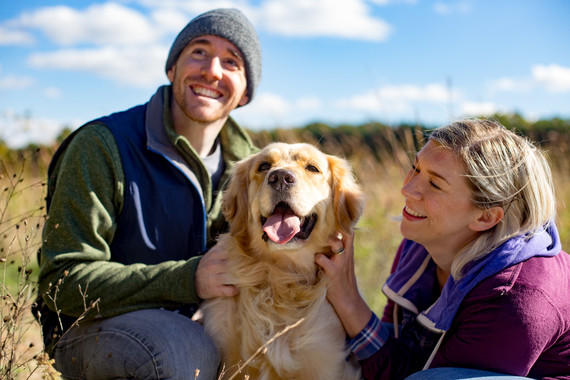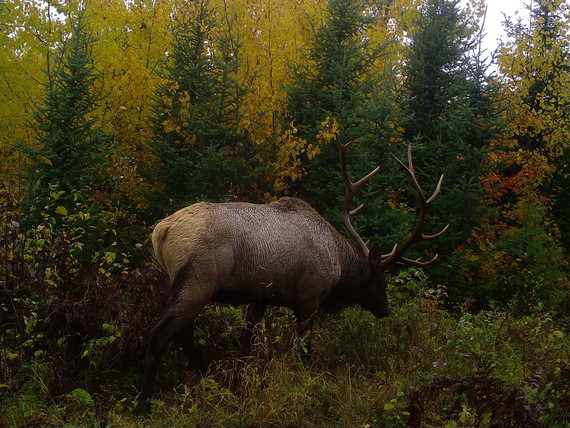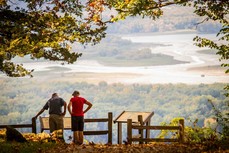DNR Parks And Recreation News
What’s Happening In Wisconsin's State Parks,
Trails, Forests And Recreation Areas
 Photo Credit: Travel Wisconsin/Rachel Hershberger
Finding Your Adventure With Pets
For many households, bringing their fluffy family members on adventures in Wisconsin's outdoors is part of the routine. A lot of us bring our pups on hikes, into the water or even out on the ski trails. When bringing them to the parks, remember these tips to keep all visitors safe our properties clean.
- Pets must be on leash no longer than 8 feet.
- Pets must be under control: Not everyone loves a stranger's dog! Please, do not let your pets interfere with other people's enjoyment of the park. Leaving your pet unattended for periods of time is inconsiderate to other park users and exposes you, and your pet, to potential problems.
- Not all areas of park properties are open to pets. Please check before bringing your pet with you and observe all signs.
- If your pet is lost, inform a park ranger and immediately call the local authorities to find the location of the nearest stray-holding facility.
- Pack out the poop, just like any other waste. Pet owners are responsible for the proper removal and disposal of their pets' waste products. Waste should be disposed of in dumpsters or trash receptacles. Leaving plastic bags of waste on trails is inconsiderate to other users. Park staff are unable to check all trails at the end of every day, and litter is not picked up.
-
Dog-powered sports are allowed in state park properties.
Please respect where pets are welcome in each property. Pets are permitted in most campgrounds, trails, roads and outlying areas of the parks. At the same time, pets are not allowed in some places (this rule applies to all pets except service animals helping people with disabilities), such as buildings and picnic areas and shelters; beaches, except designated pet swim areas; playgrounds and observation towers.
Additionally, some properties have "pet-free" areas including the quiet area at Loop 1 of the Pinewoods Campground in the Southern Kettle Moraine State Forest. Pets are not allowed anywhere in Copper Culture State Park, Heritage Hill State Park and Hoffman Hills State Recreation Area.
People And Pet Safety
Pets can be fun for you and your family, but remember that like people, they each have a unique personality.
- Always ask before meeting dogs, whether you have a dog with you or whether you see a dog you want to meet.
- Share trails with other people and pets that you pass.
- Pets need water when they're hiking, and can get dehydrated, so plan accordingly when heading out. Keep treats as snack or reward during a long day of adventuring.
- During hunting season, consider using a bright orange vest or bell on your pup.
- Make sure tails, ears and other extremities are kept away from fires.
- At the end of the day, kick back, stretch your legs and enjoy a few bellyrubs in front of the campfire.

 Photo Credit: Snapshot Wisconsin
Wisconsin's wildlife enjoy experiencing fall foliage like we do!
Here, a bull elk walks through some fall foliage captured in this Snapshot Wisconsin trail camera photo from Bayfield County.
Once widespread in Wisconsin and across North America, elk were eliminated from the state in the 1880s due to unregulated hunting and habitat loss. Over 130 years later, they once again live in the central and northern forest regions of our state. From a population of 25 elk reintroduced in 1995, and with the help of the second reintroduction efforts that started in 2015, the state’s total elk population has now surpassed 400 animals.
Elk are found in two distinct ranges in Wisconsin. The largest, and oldest, elk herd in the state is the Clam Lake elk herd. The Clam Lake herd ranges across Ashland, Bayfield, Price, Sawyer and Rusk counties in northern Wisconsin. The other, the Black River elk herd, is found in the forested region of Jackson County in the central part of the state, including at Black River State Forest.
Thanks to the support of multiple partners and the backing of Wisconsin citizens, the bugle of rutting September bulls is back and here to stay.
Snapshot Wisconsin is helping professional and community scientists to monitor wildlife, including elk. Snapshot is a partnership to monitor wildlife year-round using a statewide network of trail cameras. The project provides data needed for wildlife management decision support. It is also a unique opportunity for individuals, families and students to get involved in monitoring the state’s valuable natural resources.
You can witness the biodiversity of Wisconsin and view elk safely from home at SnapshotWisconsin.org.

Wyalusing State Park
At Wyalusing State Park, you can camp 500 feet above the confluence of the Wisconsin and Mississippi rivers and explore the view across Wisconsin and Iowa.
One of Wisconsin's oldest state parks, Wyalusing features family and group campsites, year-round hiking trails, a canoe trail, bird watching, bicycling, snowshoeing and cross-country skiing with bluff-top overlooks.
Long before it was a state park, the land that is today Wyalusing has a long history.
People began arriving to this area about 11,000 years ago, as the glaciers retreated. Many left evidence of their life and culture behind. The Red Ochre Culture appeared around 1000 B.C. They were followed by the Hopewell Indians and the Effigy Mound Builders. Archeologists tell us that these groups were the builders of the many mounds on Sentinel Ridge, Spook Hill and other areas of the park.
Some land features in the park have been named for Native Americans of the region. Green Cloud Hill Picnic Area is named for the Winnebago chief who led the last band of Native Americans to camp in the park. Other areas in the park received names for the way they were used by the Native Americans.
Exploring Wyalusing today, you can still see evidence of the land's rich history. Effigy mounds, constructed for burial, ceremonial or perhaps religious reasons, are evident to this day. You can visit Signal Point, which was used for signal fires. Sentries used Point Lookout to keep watch on the rivers.
As Europeans arrived, fur traders, miners and farmers all used the land in and around Wyalusing. Remnants of these uses are still found there today.
Visiting the sand caves, exploring the Old Wagon Road Trail or paddling the Mississippi Water Trail can take visitors back in time. The Huser Astronomy Center takes visitors to space with nighttime sky views.
Get out to explore Wyalusing State Park in Bagley (Grant County).
Photo Credit: Dixie Brumm, Wisconsin DNR
|
Corn Husk Doll Making
Richard Bong State Recreation Area
Saturday, Nov. 5
10 a.m. - noon
Connect with the past by learning the fun art of making toy dolls out of corn husks. Recommended for ages 12 and up. Registration is required; please call 262-878-5609. Meet in the Visitor Center Auditorium.
Create A Winter Wreath With The Friends Of The Kettle Moraine
Kettle Moraine State Forest - Northern Unit
Thursday, Nov. 10
1 - 3:30 p.m. OR 6 - 8:30 p.m.
Using a variety of natural materials, create a beautiful winter wreath and swag. To register, call 920-533-8322 by Nov. 8. Cost: $20.00/person; fee payable to Friends of the Kettle Moraine. A Wisconsin State Park vehicle admission sticker is required.
Meet at the Zillmer Trail Shelter (located at W833 County Road SS, Campbellsport - between County Road G and Hwy 67 near New Prospect).
Find more nature programs and DNR events.
What are your favorite dog-friendly hikes?
Share on social media using #OutWiGo!
|